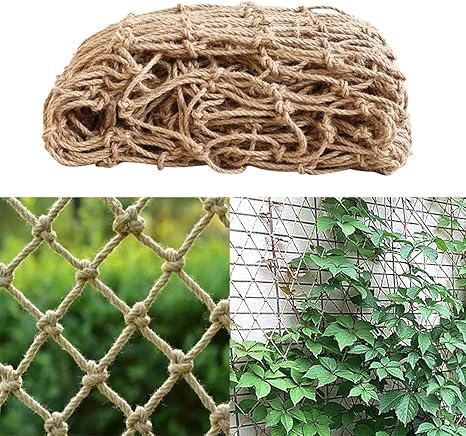- September 6, 2024
- Posted by: wellcoindustries
- Categories: Erosion Control, Jute Mesh
Introduction
In recent years, jute plant support netting has become an essential tool for gardeners and farmers alike. Offering an eco-friendly solution for plant support, jute netting provides numerous benefits, including sustainability, durability, and versatility. This article explores the various advantages of jute plant support netting, its different applications, and practical tips for effective use. If you’re looking to enhance your gardening or farming practices with a sustainable option, jute plant support netting might be just what you need.

What is Jute Plant Support Netting?
Jute plant support netting is a natural, biodegradable material made from the fibers of the jute plant. It is woven into a netting form, which can be used to provide support for a wide range of plants, from climbing vegetables like beans and cucumbers to ornamental flowers. Jute netting has been used for centuries in various cultures due to its affordability and natural strength, and today, it remains a popular choice for those seeking an eco-friendly plant support solution.
Benefits of Jute Plant Support Netting
Eco-Friendly and Sustainable
Jute is a renewable resource that grows quickly, making it an excellent sustainable option. Unlike synthetic materials, jute is biodegradable, meaning it will break down naturally in the environment without leaving harmful residues. This quality makes it ideal for gardeners who prioritize sustainability and want to reduce their carbon footprint.
Durable and Strong
Despite its natural origins, jute is known for its durability. It can withstand various weather conditions, including heavy rains and strong winds, providing reliable support throughout the growing season. This strength ensures that even the most delicate plants remain upright and healthy, reducing the risk of damage and improving overall yield.
Biodegradable and Compostable
One of the most significant advantages of jute plant support netting is its biodegradability. At the end of its use, jute netting can be composted along with other garden waste. This feature benefits the environment and adds valuable organic material to the soil, enhancing its structure and fertility.
Different Uses of Jute Plant Support Netting
Gardening Applications
Jute netting is commonly used to support climbing plants like peas, beans, and tomatoes. It can also be used to create vertical gardens or to support delicate flowers and shrubs, ensuring they grow upright and healthy. Gardeners often use jute netting in greenhouses and small garden spaces to maximize vertical space and increase plant density.
Agricultural Applications
In agriculture, jute netting helps provide structure to plants, reducing the risk of damage from wind or rain. It is often used in orchards and vineyards to protect young trees and vines. Additionally, jute netting can be employed to support vegetable rows, preventing them from falling over and making harvesting more accessible and efficient.
Landscaping Uses
Beyond gardening and agriculture, jute plant support netting can be used in landscaping projects, such as creating living walls, supporting young trees, and stabilizing slopes by holding soil in place. The versatility of jute netting makes it a popular choice for landscape architects and designers looking for natural, aesthetically pleasing materials.
How to Use Jute Plant Support Netting Effectively
Installation Tips
To maximize the benefits of jute netting, it is crucial to install it correctly. Start by measuring the area where the netting will be used and cut it to the desired size. Attach the netting to sturdy stakes or poles, ensuring it is taut enough to support the plants but not too tight to prevent growth. It’s essential to place the stakes deep enough into the ground to withstand wind and provide adequate support.
Maintenance and Care
Jute netting requires minimal maintenance. However, checking regularly for any signs of wear or damage is essential. If a section of the netting becomes weak, it can be replaced or reinforced with additional material. During the growing season, gently guide plants onto the netting to ensure they receive adequate support.
Seasonal Considerations
In colder climates, jute netting can be removed at the end of the growing season and stored indoors to extend its lifespan. In warmer regions, it may be left in place year-round, provided it does not show significant wear. Regularly inspecting the netting before the new planting season will help determine if it needs replacing or repairing.
Choosing the Right Jute Plant Support Netting
Factors to Consider: Size, Quality, and Purpose
When selecting jute netting, consider the specific needs of your plants and the size of your garden. High-quality jute netting will be tightly woven and free from defects, ensuring it lasts longer and provides better support. For heavier plants, opt for thicker and more robust netting to ensure adequate support.
Where to Buy and Pricing Considerations
Jute plant support netting is available from various retailers, including garden centers, online stores, and agricultural supply shops. Prices can vary depending on the quality and size of the netting, so it’s essential to shop around and compare options. Purchasing in bulk can also provide cost savings for larger projects.
Conclusion
Jute plant support netting offers a practical, eco-friendly solution for gardeners and farmers looking to provide sturdy, natural support for their plants. With its numerous benefits, such as sustainability, durability, and versatility, it’s an excellent choice for anyone seeking to enhance their gardening practices. Consider adding jute netting to your gardening toolkit today and experience its benefits firsthand.
Call to Action
Are you ready to switch to a more sustainable gardening solution? Explore our range of jute plant support netting and find the perfect fit for your needs. Start making your garden greener today!
